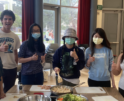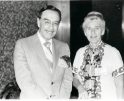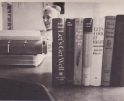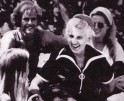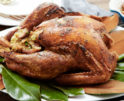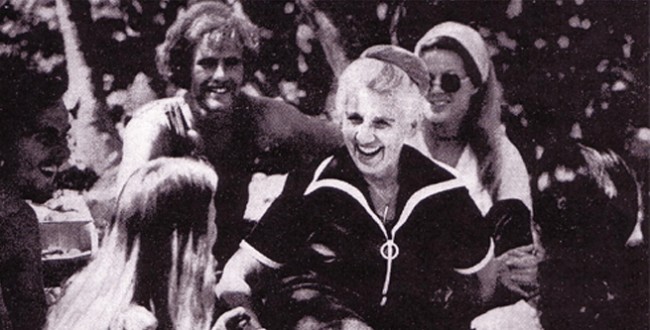
Homage to Adelle Davis.
By, AmShazam.
When I was a child, one of my favorite places to play was in the pantry. We lived in a house built in the 1920s, and it had a marvelous walk-in pantry that jutted out from the back of the north side of the house and — like a pantry ought to — stayed cool in the summers and even cooler in winter. You could keep a bushel of Northern Spies in there from November clear through March and they’d still be alright for eating. I had some kids’ Tupperware baking supplies and my play-dough (homemade, of course) in there, but the climbable pale yellow wooden shelves stocked with cans and boxes and jars, the Kitchen Aid, various utensils and pots and less-often-used pans and equipment (the tortilla press, the yogurt maker) were just as much fun as any toys. I had a pale yellow wooden stool my dadhad built to sit on, the onion bin to play in, and a door to close for the privacy children always need. It was the best playroom ever.
All of this may explain some part of why I am such a food person today, but there are two things in particular that I remember very clearly from my cool and happy days alone in the pantry, apart from such endlessly fascinating curiosities as the chimneysweep figure made of prunes or the Indonesian ladles made from coconut hulls, and these things are certainly important to my culinary development. The first was a poster that was on the back of the door, so that it was visible when you were inside with the door shut, entitled “The Chemical Kitchen.” Mostly I remember the image at the top, which was of a vaguely psychedelic, early-’70s-style cloud-looking man’s face, with long hair flowing to the sides and around the blocks of text. The colors were pale greens and blues and purples, and the content detailed all the toxics one could find on fruits and vegetables, in processed foods, and the like. The other was a large cardboard Quaker Oats canister, tall and cylindrical, with a masking-tape label across the front that read, in my mother’s Palmer-Method hand, “Nutritious Mix.”
“The Chemical Kitchen” wasn’t something I ever consulted myself, and I’m not sure my mother looked at it much either — no doubt she had long ago committed to memory everything it said — but I think it sums up well the way my mother and her mother thought about food. It was a poster printed in the 1970s, but it pointed to something much older, something expressed well by the canister of nutritious mix, which is a quick-bread mix from Adelle Davis’s 1947 Let’s Cook It Right. Davis is generally thought of as a nutritionist, in the same way that Rachel Carson is cast as an environmentalist; but, like Carson, she is deserving of broader recognition as a critic of not just a particular industry (food, pest control) but of a larger system of agricultural production and human interactions with the natural world. She fits into a lineage that includes people like Sir Albert Howard, J. I. Rodale, Carson, and, more recently, Frances Moore Lappe and Michael Pollan. You could probably put Aldo Leopold in there, too, and certainly Wendell Berry. Davis’s “Let’s” series of books had a resurgence of popularity in the 1970s, and the copies you generally find in used bookstores are the paperbacks that were bestsellers in this period.
I’ve been thinking of these things lately because, about a month ago, I brought my copy of Let’s Cook It Right with me to Whole Foods so that I could pick up all the ingredients for nutritious mix. When I got home, I mixed up a half batch, and yesterday I threw together another, as I had depleted the first batch so much making pancakes almost every morning. There is something about the taste of baked goods made with nutritious mix that takes me right back to my childhood — back to the cool, pale yellow pantry — and a breakfast of Adelle Davis pancakes is indeed a breakfast of champions. Of late, I’ve been serving them with a raspberry sauce, plain yogurt, and maple syrup. It is heaven.My grandmother deserves most of the credit for how my family has always eaten, and for how I eat (and how Paul eats!) today. Madison has been good for me in this regard too, but every time I read an article about the “new” craze for organics or the latest “discovery” about the nutritional value of whole, unprocessed foods, I think of my mother, of my grandmother, and of Adelle Davis, and a smile a knowing smile to myself. Because, you see, we already knew that.
Source: http://amrys.wordpress.com/2009/05/10/homage-to-adelle-davis/
Recommended
-
UCSB CooksJuly 19th, 2022
-
Fight COVID 19 Through Good NutritionAugust 30th, 2020
-
The Womans Hour: Adelle DavisAugust 30th, 2019
-
Adelle’s 113th Birthday!February 25th, 2017
-
Adelle Davis’ Perfect TurkeyNovember 23rd, 2016

